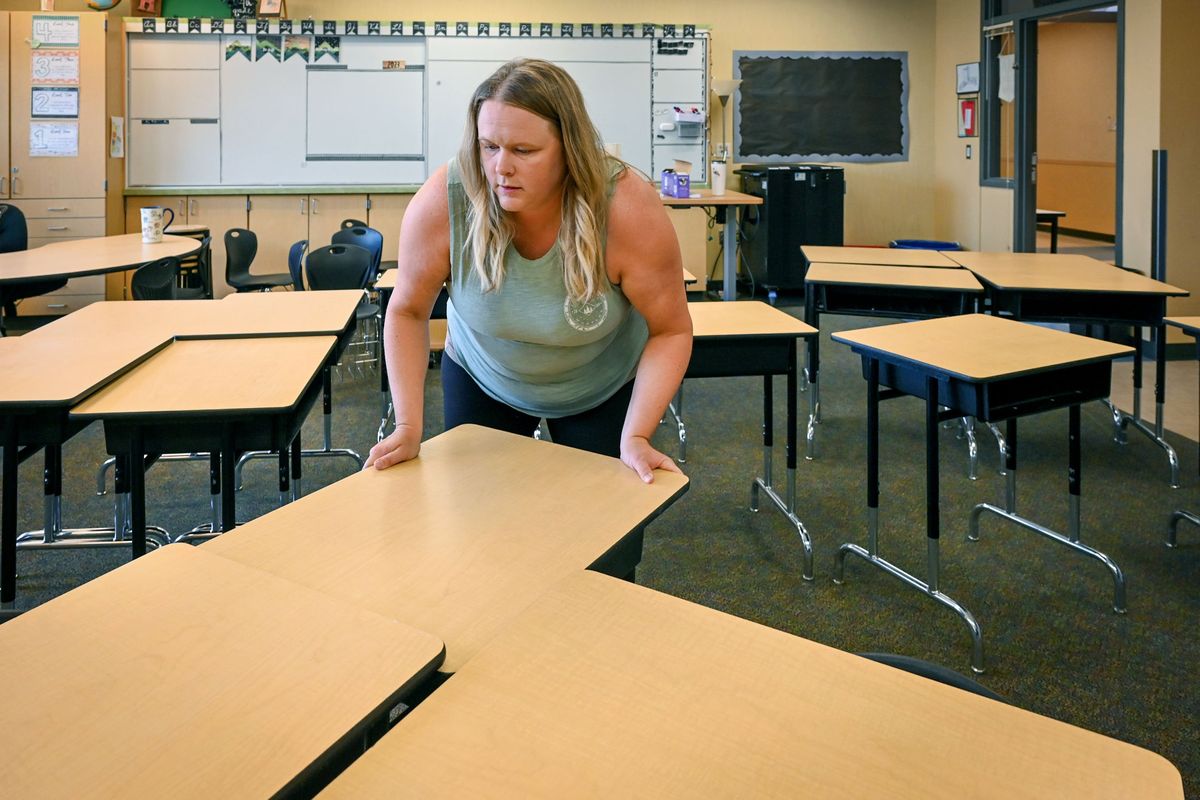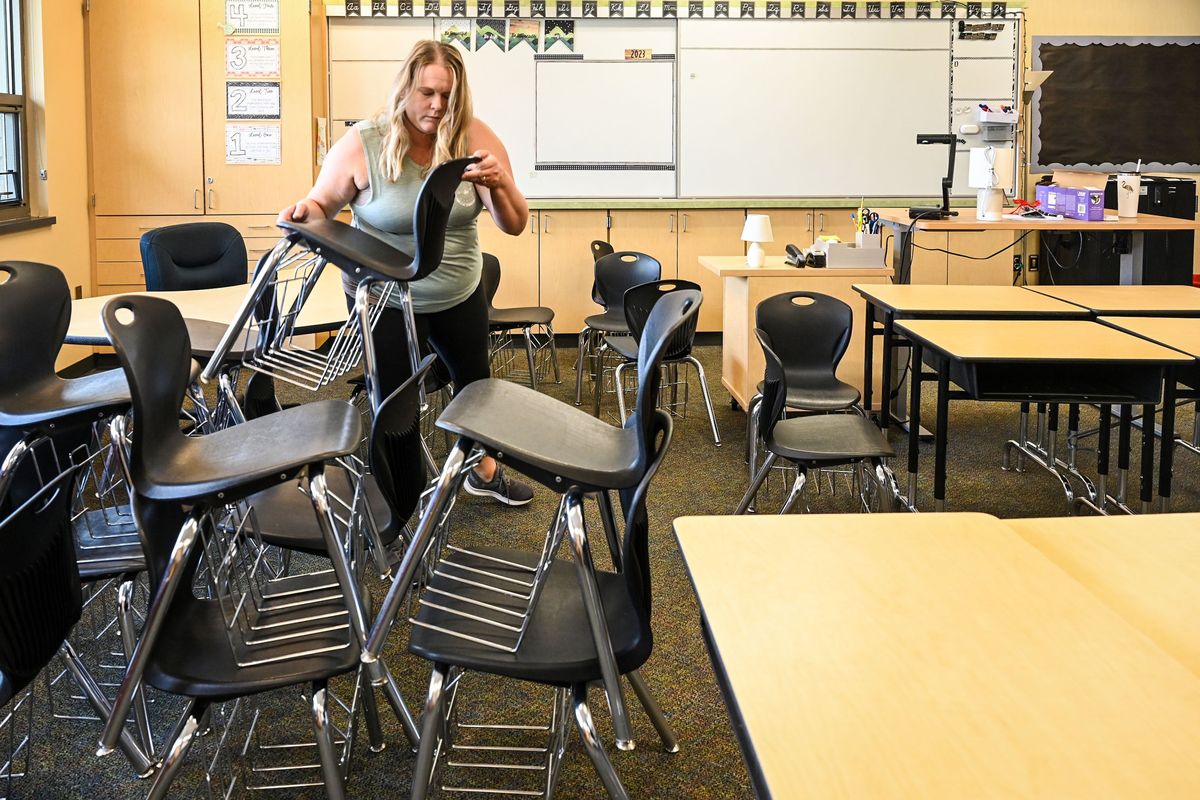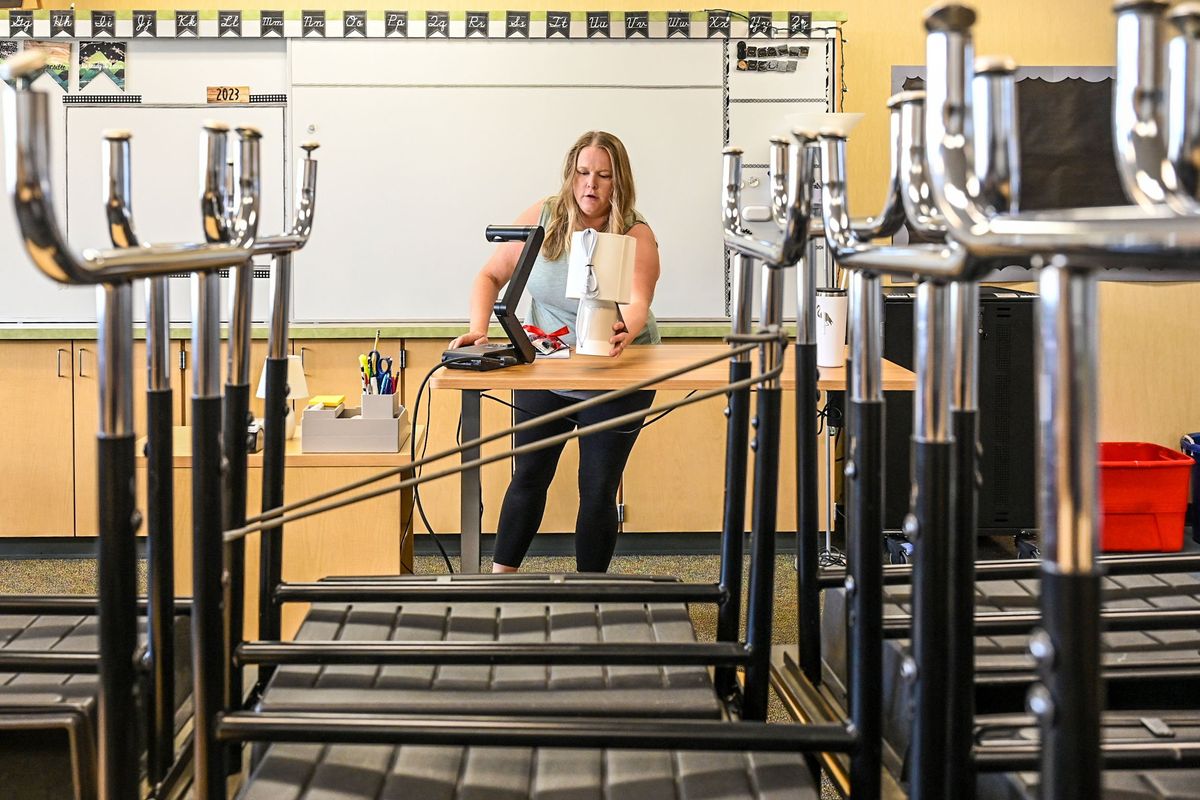Freeman School District to implement more balanced calendar
Freeman Elementary School fourth-grade teacher Desiree Hendrickson sets up her classroom on Wednesday, Aug. 16, 2023, in preparation for the start of school on Aug. 30. Hendrickson will be beginning her 10th year at Freeman. (DAN PELLE/THE SPOKESMAN-REVIEW)Buy a print of this photo
When the last school bell rings in the Freeman School District come June, students might groan about having a shorter summer.
But then, like a growing number of students attending schools experimenting with a balanced calendar, they’ll have more breaks to look forward to during the school year.
It’s part of a trend encouraged by state education leaders to move from near-constant instruction for nine months with a long summer punctuating the year to a shorter summer with more frequent breaks.
Endorsed by a grant from the state Office of Superintendent of Public Instruction, Freeman School District altered its calendar in the 2024-25 school year, transitioning to a more balanced distribution of the state-mandated 180 instruction days.
Freeman, a small district of fewer than 900 students and three schools sharing the same land a street off state Highway 27, is making three calendar adjustments next school year. School will start a week sooner, kicking off on Aug. 21, compared to this year’s first day on Aug. 31.
Students will be eased into the calendar with weeks at the beginning of the school year, as is typical for the district’s calendar, with the first week three days long and four days on the second and third week. In November, Freeman students and staff will have a full week off for Thanksgiving break, rather than two days. Finally, the end of the semester at Freeman will be Dec. 20, the day before winter break, rather than a few weeks after students return from their break in January like in years past.
“We feel this is the first step in probably several steps that we’ll need to take over the next three or four years to kind of ease into it,” Freeman Superintendent Randy Russell said. “So the ’24-’25 school year will really be kind of a test pilot for Freeman.”
The changes won’t affect activities or sports, Russell said, and while the semester shift results in a lopsided second semester of about three weeks, the spring leaves ample time for state and Advanced Placement testing and days budgeted for end-of-year hoopla.
The noticeable slide in a student’s learning after months out of the classroom, requiring additional review at the start of the school year, motivated Freeman in changing their calendar.
“I feel like we can shorten a little bit of the learning loss break between the end of the school year and the fall,” Russell said.
Desiree Hendrickson, a fourth-grade teacher and self-described “neutral person,” said she appreciated the slight changes to the calendar as a way to wade into the concept.
“I think it’s wise to just be like, ‘OK, how did that work? And then what is the next step?’ ” Hendrickson said.
Both Hendrickson and fifth-grade Freeman teacher Alicia Thompson said they felt the Thanksgiving break extension was logical, especially given lowering attendance trends that week.
“If we have a big chunk of kids being gone, then we feel like we need to reteach, or we’re not teaching the curriculum because we have so many people gone,” Thompson said.
The earlier first day initially jarred Thompson, but she said she’s noticed a learning slide in her own son during summers, and she thinks an abbreviated break may slow that loss.
Thompson, a teacher of 10 years, said the summers give teachers a chance to breathe after the stress of the school year. She relishes her summers, but said the winter-to-spring period is when she feels the burnout begin to settle in.
“Myself, I feel it more in that January, April time,” she said. “Just to have a time to decompress as well, you know? It’s hard.”
Hendrickson said there are many unintended consequences of changing the calendar that vary from person to person. She has an annual family gathering at the end of August that she’ll have to cut short when the calendar goes into effect.
Many staff use their months away from the classroom to pick up another job to supplement their income. Students who often get summer jobs would also be affected.
‘The balanced calendar experiment’
A “balanced calendar” varies district by district, ranging from Freeman’s cautious approach to a more year-round version like at East Valley’s Continuous Curriculum School, which began school on Aug. 16 and follows a pattern of six weeks instruction to two-week-long embedded breaks and six-week summer.
Freeman is one district in a statewide push toward exploring alternative calendars; the district was among 45 others in Washington to receive grants from the state to explore with no commitment to change. The state school superintendent’s office offered the grant in the interest of quelling the learning slide in students after the traditional nine-week summer.
Freeman received $60,000 to assemble a committee to visit districts across the country with an implemented alternative calendar, including schools in San Diego, Reno and Mount Vernon, Washington.
While Freeman is the only district in the Spokane area to explore the prospect in this capacity, Central Valley School District has included exploration in its five-year strategic plan, and West Valley School District Board President Dan Hansen said West Valley also is interested in exploring the idea.
John Lupinacci, associate professor of cultural studies and social science education at WSU and a former teacher who has studied school calendars, is a “big fan of the balanced calendar experiment.”
Lupinacci, who has taught at schools with both calendars, said the more frequent breaks are beneficial for students’ learning retention, and for both staff and student well-being.
During breaks, Lupinacci said students can apply their learning in other ways, whether through activities facilitated by the school or through participation in their communities and intergenerational time spent with families.
“Teachers need breaks, students need breaks. When you step away, you can process in a way where you really develop some long-term memory of things and some mastery,” Lupinacci said.
Burnout and demoralization is an increasing phenomenon among teachers, he said, and the more frequent pauses to instruction could offer some reprieve from stresses in and out of the workplace.
“We need as human beings to be able to slow down like this. The speed of things has gotten so fast-pace, potentially harmful to us as biological creatures,” he said.
Balanced calendars don’t look the same in every school, and Lupinacci said that’s the beauty of the schedule. Each entity can tailor its calendar to best suit its needs.
“There isn’t a silver bullet to rethinking education, there isn’t one best fit, one-size-fits-all,” Lupinacci said. “But there is information out there that shows us that teachers and kids need breaks. But they also can benefit greatly from some continuity.”


